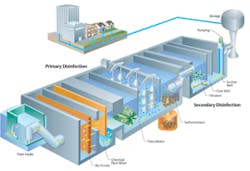The city of Fort Wayne, IN, isn’t unlike many other municipalities across the country. It uses a Supervisory Control and Data Acquisition (SCADA) system to track the water that flows from its water utility to its customers. But the data generated by that system is stored in several places, some of which are accessible to some employees but not others. And the raw numbers generated by the municipality’s SCADA system can sometime prove overwhelming.
This makes it difficult to interpret and analyze the data generated by the city’s SCADA system. Fort Wayne officials, for instance, have to deal with three rivers that wind through the city. During the last four years, the rivers have flooded their banks several times. City officials would like to more quickly be able to determine just how much river water managed to seep into the city’s sewer system.
That’s something that won’t be easy to do until the information from sources such as the city’s SCADA system, permanent flow meters and the US Geological Survey river gauge system are all combined in one location.
“We’d like to get a bigger picture of the impact,” says Wendy Reust, program manager and engineer for the city of Fort Wayne. “Right now we have multiple places where we store data in little bits. Some of our employees have access to it all; some don’t. It’s hard for us to combine our information into one platform and make that information available to everyone who needs it.”
This was scheduled to change, though, by the middle of June. That’s when Fort Wayne’s new online data-analysis program from Seattle, WA, firm FlowWorks was scheduled to be up-and-running.
With FlowWorks’ help, City of Fort Wayne officials will now be able to combine all the SCADA-generated water use data from the municipality in one place. And, they’ll be able to analyze trends. If water use in one section of the city suddenly spikes, Fort Wayne officials can search for system leaks or open hydrants. If the city has instituted a water conservation program, municipal officials can analyze SCADA data to determine if their efforts are actually encouraging business and residential customers to consume less water.
In other words, the combination of SCADA and remote management systems–those systems that allow utilities, usually through the installation of software, to monitor and analyze water use data from remote locations–can have a dramatic positive impact on the ways in which utilities manage their water resources. This powerful combination can also help utilities determine if their aging infrastructure is no longer operating efficiently enough to justify pouring more dollars into its upkeep.
Selling the Benefits of SCADA and Remote Management
Doug Johnson, vice president of global supply chain in the Pittsburgh office of Emerson Process
Advanced data collection software in action
Management, can quickly list the many benefits that water municipalities enjoy by taking their SCADA systems to the next level and pairing them with online tools that allow them to not only collect water use information, but to analyze it.
For instance, by monitoring the data that their SCADA systems pull out, municipalities can better determine when to backwash their filters. Many municipalities today simply backwash filters on a set schedule, whether once every five weeks, or once they hit a set number of operating hours.
This, though, is far from the most cost-effective way to handle this important maintenance requirement.
“Rather than just backwash, because it’s the time at which they’re supposed to do it, municipalities can instead use their SCADA systems to optimize the process,” says Johnson. “Municipalities can look at when they need to backwash their filters, not when they’re scheduled to do it. In some cases, municipalities are backwashing their filters earlier than is necessary. In most cases, we are finding that they can extend the time between the backwashes, and the life of their filters, if they analyze their system first with data provided by their SCADA systems.”
This can save municipalities a significant amount of money. By backwashing their filters less frequently, they’ll also consume less energy.
And that’s just one example. Johnson also points to a utility in North Carolina with which Emerson Process Management is working. This utility had set up its water system so that it continually maintained a certain level of drinking water in its tanks.
Problem was, the way the utility was doing this was costing it money.
By analyzing its energy data through its SCADA system and a data-analysis tool, the utility determined that it was pumping far too much water into its storage tanks at the wrong time of day, the time at which energy fees were at their highest. At the same time, the utility was often filling its tanks when it needed to pump its water against stronger backpressure. This made the utility’s pumps work harder than they needed to, costing the utility even more in unneeded energy consumption.
Thanks to its data analysis, the utility now has automatically programmed its pumps to send water into its tanks during the part of the day when the energy company charges lower rates. The utility also pumps when there is less backpressure in the tanks, which means it uses less energy now to pump the same amount of water into the tanks.
Then, there are the larger examples of utilities tapping into the real power of SCADA to save money and better manage their water resources.
Johnson says that in many parts of the countries, municipalities are banding together to share infrastructure and combine services. It’s a way for cash-strapped municipalities to enjoy some savings during tough economic times.
Municipalities might form a regional water authority as part of these efforts. This might save money. But it does present a possible problem: How can each municipality manage its own water custody? How can municipalities best determine which has used the most water? How can they determine if one utility in the authority is consuming more than its fair share?
The combination of SCADA and online data-analysis tools provides the solution. The municipalities in a regional water authority can use this combination to see exactly where the water is going each day.
These are all impressive examples of how SCADA systems and online remote-management tools, when used properly, can help municipalities and utilities better manage their water, save money, and operate more efficiently.
Spreading the Data Analysis Message
But are municipalities getting the message? Do they understand that SCADA isn’t just a source of data but is a tool that can help them better manage their entire water distribution system?
SCADA helps with largescale systems control.
Johnson says that they are. “The message is beginning to get out there,” he says. “But it is largely incumbent on the people who are serving in this industry, the people like us, to get that message out.”
Grant Van Hemert, applications specialist for Schneider Electric’s Water and Wastewater Competency Center, says that municipalities have actually been slower to tap into the full power of SCADA than private businesses.
And that’s unfortunate. By monitoring the data that SCADA systems generate, municipalities struggling with tight budgets can enjoy financial relief.
Van Hemert points to leak detection as one example of the significant savings municipalities can enjoy when they turn to SCADA and remote-management tools as a way to monitor and analyze water distribution data. It all comes down to delivering more water for less cost.
Here’s a simplistic example: A utility might spend $100 million to deliver water to the businesses and households it serves. But if this utility loses $10 million worth of water during treatment at its plant, and then loses another $10 million during distribution, it’s actually spending its $100 million allocation in an inefficient manner.
By using remote-management tools to analyze the water use data that their SCADA systems generate, though, utilities can quickly determine where major leaks are occurring. They can then send crews out to fix these leaks. Maybe, thanks to the water use data provided by their SCADA systems, a utility can repair enough leaks to prevent $10 million worth of water from leaving its system. Now the utility is spending its $100 million in a more efficient manner. It’s still not ideal; in a perfect world, the utility would not lose any money through leaks. But thanks to SCADA and data analysis, the utility is at least operating more efficiently.
“It’s about increasing the efficiency of your water-distribution system,” says Van Hemert. “It’s about consuming less energy to deliver water to your customers.”
Putting a Lid on Firings
By better analyzing the data generated by their SCADA systems, municipalities can also help prevent the painful firings of key personnel, Van Hemert says. Towns, cities, and villages across the country are still under pressure in today’s weak economy to reduce their operating costs.
One way for municipalities to avoid layoffs is to consume less energy by carefully analyzing the data their SCADA systems mine, explains Van Hemert. With advanced SCADA in place, municipalities can determine where leaks might be occurring in their systems, discover which customers are consuming more water than others, and take steps to encourage changes in consumption habits. Utilities can even take steps to pump more of their water when their local energy utilities are charging at a lower rate.
Of course, SCADA alone can’t do this; it is more of an automation tool than it is a data-analysis tool. But companies like Schneider Electric provide the software that water utilities can use to not only accumulate statistical information but to analyze it too.
It’s by going to this next level that utilities can truly shave big dollars off energy bills, provide water to end users more efficiently, and better maintain infrastructure, Van Hemert says.
And when they save money in this way, utilities don’t have to cut costs in more unpleasant ways, like reducing its labor force.
“Municipalities don’t like firing people; no one likes that,” he adds. “So why not cut energy costs instead? SCADA is a wonderful tool for real-time analysis of your system. It’s not designed to provide a longer-term view of how a water distribution system is working. You need the higher-end analytical tools for that.”
Van Hemert says that when municipalities commit to not only using SCADA, but analyzing the data that such systems provide, they can more effectively use their water-system personnel.
That’s another message that SCADA and software providers are spreading to municipalities. For example, if municipalities can pinpoint a leak, they can then send a repair crew to an exact location to fix it. These crew members will no longer have to search a general area to determine where water is leaking. This saves time and money spent in labor costs, a benefit that higher-level municipal authorities can understand and appreciate.
By using SCADA and data-analysis software, municipalities can take monitoring duties away from employees, something that frees these workers to concentrate on other duties, whether it’s answering phone calls from customers or beefing up the municipality’s repair crews, both moves that can dramatically increase customer satisfaction.
A Bright Future for Data Analysis?
But most municipalities aren’t quite there yet. A vast number are already using SCADA systems to automate water distribution systems, but they’re not using the data those SCADA systems provide to make long-term operating decisions or to increase efficiency.
According to Van Hemert, it’s the larger utilities operating in major metropolitan areas that have become the first adopters of SCADA data analysis. It’s the smaller and medium utilities that are slow to come on board.
Van Hemert likens the situation to the 1970s and 1980s, when, the largest facilities ran SCADA systems but no one else did. Today, larger metro municipal utilities rely not only on SCADA for automation, but also for the raw data they can later study with analytical software.
Van Hemert believes that, as time moves on, smaller cities, towns, and even rural villages will embrace data analysis through remote management of their SCADA systems and all the benefits that it can provide.
“And it won’t always have to do with size,” he says. “There might be a high-end ski resort in Colorado that does this because it makes enough income each year that it can afford SCADA and remote management. It’s not just the bigger players that will be looking for this tool. Any municipality or private enterprise that wants to deliver water in a more efficient way can benefit from using SCADA and data analysis tools.”
Johnson from Emerson Process Management agrees that the future looks bright for SCADA as a growing number of potential clients come to understand the benefits remote monitoring of water use data can provide.
Not only are public works directors and water plant operators now beginning to understand SCADA’s potential, Johnson says higher-level government officials are as well.
And that’s the key to wider acceptance, he declares.
“We are seeing a lot more interest in general in the benefits that SCADA can provide at much higher levels within a municipal organization,” says Johnson.
“In the past, it had largely been the realm of the people working at the treatment plants and in the collection systems. Now, the awareness of what SCADA can do is moving higher in the organization. Mayors, city planners, chief operating officers–people like that are becoming more aware of the benefits. They are becoming more aware of how analyzing water use data can directly impact the financials of a municipality.”
Part of the reason for this? The manufacturers providing SCADA technology have refined their message. In the past, Johnson explains, manufacturers focused on the technology that made up SCADA systems. They focused on the fact that by using SCADA systems, municipalities could gain better and tighter control of their treatment processes and distribution systems.
That’s a powerful message. But higher-level government officials aren’t interested in an in-depth look at SCADA technology. They’re more interested in whether SCADA can, over the long term, save their municipality energy and operating costs.
“Now we are speaking a language related to the importance of reducing energy consumption,” says Johnson. “That has made a big difference. We are talking about improving sustainability and improving security. This message takes us out of the world of the technical benefits that we bring and puts us in the world of benefits that are important to the people at the more senior levels of a municipality.”
Of course, municipalities need the right tools to realize these benefits, tools designed specifically for data management, says Timothy Hicks, president of FlowWorks, a company that sells a wide variety of online data collection, monitoring, and analysis tools.
Such tools allow utility operators to determine just how efficiently their systems are running. And armed with this information, operators can take the necessary steps to boost their systems’ performances.
“SCADA is for control,” says Hicks. “If you are trying to control your system’s pipes and valves, you need SCADA and all the things you can do with SCADA. But if you are trying to gather and manage data, without control, the best option is the products that companies like ours produce.”
As an example, SCADA provides utilities with enough information to determine what their peak water flows were for the months of June and July. But that’s only a bare amount of information. Armed with online data-analysis tools, such as the online services offered by FlowWorks and Schneider Electric, utility operators can supplement the information generated by their SCADA systems.
As an example, online data acquisition tools can pull out operational data from the SCADA numbers to tell utility operators that their peak water flows took place exactly at 10:30 a.m. on June 15 and 1:30 p.m. on July 20. Water system operators can then determine if there’s a reason for this. Maybe the city experienced a major leak at these times, for instance.
This is important to know. Utility operators can better manage their water resources if they know that peak water flow data for a specific month is a result of increased demand or of a fluke incident. If it’s truly demand generating the peak, then utility operators can take steps to either reduce that demand or, to save dollars, shift that demand to a time of day during which it costs less to pump water.
The Importance of Data
“Data is so important to municipalities today,” says Hicks. “If municipalities are facing growth or if they are
dealing with budget cuts, they are trying to do as much as possible with their existing infrastructure. If that’s the case, then a municipality can’t get enough data. If a municipality is status quo, if they are not growing, then they can probably run without a lot of data. But if your system is under stress, you need to know as much as possible about it.”
Like most providers today, FlowWorks faces a challenge when it comes to convincing utility operators to invest in online data-acquisition tools.
Few utility officials argue that the ability to quickly analyze massive amounts of data isn’t important. But with budget cuts looming for so many municipalities, many utility operators don’t view this as the best time to ask budget-strapped city councils for extra money.
Software helps water data analysis.
Hicks, though, says that this is a short-sighted view. “Some municipalities have written RFPs [Requests for Proposals] to invest in these solutions, but the councils don’t want to write the checks to pay for it,” says Hicks. “Municipal officials, though, need to realize that these online tools actually save them money. If the engineers have all the data in one place, they don’t have to spend time rummaging around looking for it. Your water system model will be better at the end of the day. You can put in exactly the distribution system that you need and not overspec it. There are a lot of benefits to having good data in one place that is easy to access.”
This benefit remains the key to selling SCADA and online data-acquisition tools in the future, say the manufacturers in this industry.
Until a greater number of municipalities understand that SCADA and the data it provides can help their utilities save money, sales in this industry will not soar as high as they could or should.
“Automation has largely been regulated to the role of municipal operations, so the link between understanding what a SCADA system can really do for an authority in terms of helping its financial picture, its efforts to go green, and its efforts to strengthen the security of its operations is not being adequately conveyed to the executives who have the decision-making authority in a municipality,” says Johnson.
It’s important, too, for SCADA supporters to educate municipal authorities on how the in-depth analysis of water use patterns can help them as they plan for the future growth of both their utilities and their cities, he says.
This is a benefit that municipal decision-makers should embrace no matter in what financial environment they are operating, Johnson adds.
Problem is, too many municipalities today are spending most of their time trying to survive today. They’re not spending the resources they need to make sure that they’re ready for future growth and the strains that it might place on their water distribution systems.
“We really believe that a holistic approach is best,” says Van Hemert with Schneider Electric. “If you as a municipality can tie in your SCADA with data analysis, you really can make better decisions for the future of your city or metro area. And that is a trend we are seeing. Many municipalities aren’t there yet. But more are getting to this point.”




